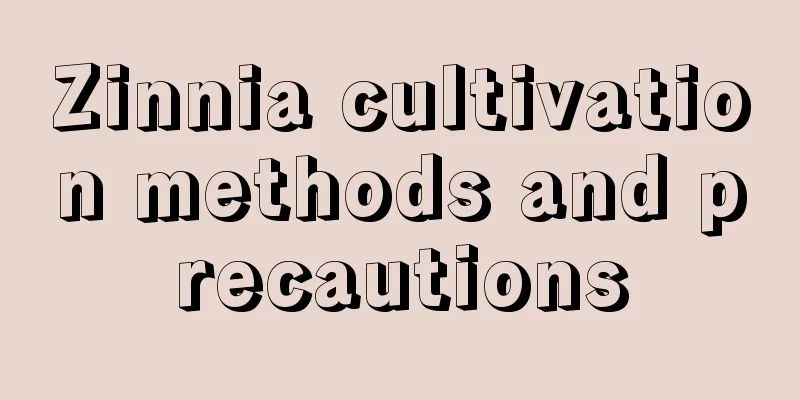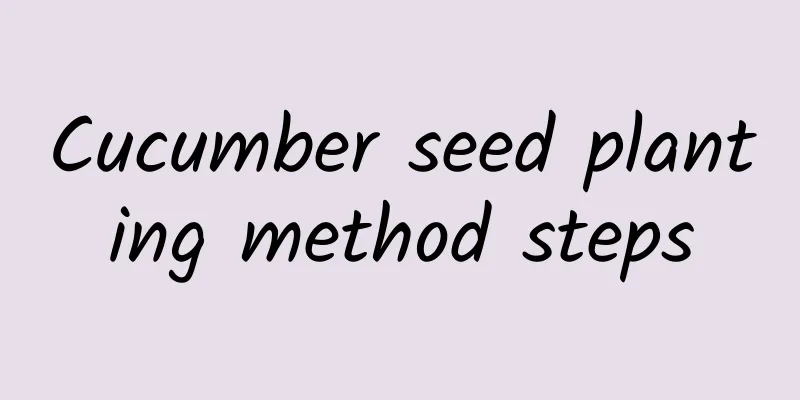Zinnia cultivation methods and precautions

1. Maintenance methods1. Temperature: Temperatures between 15 and 30 degrees are more suitable for zinnias. And because it is a plant that is neither cold-resistant nor heat-resistant, the temperature needs to be adjusted in both summer and winter. In summer, it is best not to exceed 35 degrees. In winter, try to keep the temperature around 15 degrees. 2. Watering: Zinnia is a relatively drought-tolerant plant and is afraid of waterlogging. Therefore, just keep the soil in the pot slightly dry and don't water it too much. However, in summer, due to the higher temperature, evaporation is faster, so you can water it a little bit every day. In winter, try to water as little as possible. 3. Light: It is a very light-loving plant. During its growth period, even full sun is fine. Direct sunlight will not harm it. Therefore, try not to place it in a semi-shaded place, let alone in complete darkness. 4. Soil: Its requirements for soil are mainly in terms of nutrition and air permeability. It is best to choose fertile and loose soil. 2. Breeding techniques1. Reproduction: It can be propagated by sowing. The seeds should be selected as full ones, and after selection, they need to be disinfected. The substrate should be fertile and loose, and should also be sterilized. Only then can you sow. Generally speaking, it is more appropriate to use the "on-demand" method. After sowing, cover with a layer of soil. Then, keep the temperature between 21 and 23 degrees, which will facilitate germination. 2. Repotting: Since it does not have high requirements for soil, it generally does not need to be repotted every year. However, it is not okay not to change it for a long time. Generally speaking, it can be replaced every two or three years. At the same time, try to trim the roots as much as possible. 3. Problem diagnosis and treatment1. Disease: The disease that threatens zinnia is mainly "zinnia white star disease". It causes some brown spots to appear on the leaves of the plant. It mostly harms the lower part of the leaves. Mancozeb can be used for prevention and control. At the same time, the infected leaves need to be cut off. 2. Pests: Pests may occasionally appear, such as aphids. Households can remove them by mixing laundry detergent with water. Omethoate solution can also be used. IV. Other issues1. Flower language: Its flower language varies depending on the color. If it is white, it means "kindness"; if it is yellow, it means "daily greetings". 2. Can it be raised at home? It is more suitable to be placed at home and has good ornamental value. |
<<: Is it suitable to raise succulent chicks in summer?
>>: Cultivation methods and precautions of bicolor jasmine
Recommend
What is the matter with the black spots on the leaves of Monstera? What should I do if there are black spots?
1. Strong light Monstera is suitable for growing ...
Lily Bamboo | Aquatic plants suitable for living rooms
Other Names Bamboo banana Habits It likes high te...
How to plant Impatiens seeds
When cultivating Impatiens seeds, the temperature...
What is the best season to plant ginseng fruit?
Ginseng fruit planting season and time The season...
When is the best time to plant mint?
Mint is a very special plant. It has a very fresh...
What to do if the leaves of Strelitzia turn yellow and crack
what to do If the leaves of Strelitzia reginae cr...
Cultivation method of Ephedra sinica
1. Soil Ephedra has strong adaptability and is no...
Banana Planting Technology and Management
Banana is suitable for planting in spring every y...
Cedar Pests and Diseases and Their Control
Diseases of cedar and their prevention and treatm...
Eel farming technology and management
Eel looks like a long snake. It is a fish with ri...
The flower language and cultural connotation of Weigela
Weigela flower language The flower language of We...
Can peach trees be planted in the yard?
1. Can peach trees be planted in the yard? Peach ...
How to cultivate bright red rainbow jade
Rainbow Jade Growth Conditions Rainbow Jade prefe...
Good seeds of succulent plants, easy to identify at a glance
Where to buy good seeds Recently, many people are...
Carnation disease prevention and control methods
Carnation leaf spot disease Carnations are easily...









